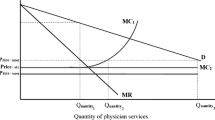Abstract
This paper investigates the impact of medical and consumerinterests on the choice of physician licensing requirements inthe United States. Using data on licensing requirements in thefifty states between 1986 and 1993, we find that, in general,public members on licensing boards are associated withlicensing requirements that have educational justification. Incontrast, medical interests, measured in terms of licensingboard independence and campaign contributions by medicalassociations, are associated with licensing requirements thatare more difficult to justify with educational criteria.
Similar content being viewed by others
References
Akerlof, G.A. (1970). The market for 'lemons': Quality uncertainty and the market mechanisms. Quarterly Journal of Economics 84: 488-500.
Arrow, K.J. (1963). Uncertainty and the welfare economics of medical care. American Economic Review, Papers and Proceedings 53: 941-973.
Becker, G.S. (1983). A theory of competition among pressure groups for political influence. Quarterly Journal of Economics 98: 371-400.
Federation of State Medical Boards of the United States (1986a). The exchange, Section 1: Flex and M.D. Licensing requirements.
Federation of State Medical Boards of the United States (1986b). The exchange, Section 3: Physician licensing boards and physician discipline.
Federation of State Medical Boards of the United States (1989a). The exchange 1989-1990: Section 1, FLEX and M.D. Licensing requirements.
Federation of State Medical Boards of the United States (1989b). The exchange 1989-1990: Section 3, Physician licensing boards and physician discipline.
Federation of State Medical Boards of the United States (1991). The exchange 1992-1993: Section 1, FLEX and M.D. Licensing requirements.
Federation of State Medical Boards of the United States (1992). The exchange 1992-1993: Section 3, Physician licensing boards and physician discipline.
Friedman, M. and Friedman, R.D. (1962). Capitalism and freedom. Chicago: University of Chicago Press.
Gormley, W.T. (1989). Taming the bureaucracy. Muscles, prayers, and other strategies. Princeton, N.J.: Princeton University Press.
Howard, R. (1998). Wealth, power and attorney regulation in the U.S. States: License entry and maintenance requirements. Publius 28.
Hyams, A.L. and Dyll, L.M. (1991). Professional practice: Licensure and discipline. In: American College of Legal Medicine (Ed.), Legal medicine: Legal dynamics of medical encounters. St. Louis etc.: Mosby Year Book, 2nd edition.
Kleiner, M.M. (2000). Occupational licensing. The Journal of Economic Perspectives 14: 189-202.
Leffler, K.B. (1978). Physician licensure: Competition and monopoly in American medicine. Journal of Law and Economics 21: 165-186.
McCubbins, M.D. and Schwartz, T. (1984). Congressional oversight overlooked: Police patrols versus fire alarms. American Journal of Political Science 2: 165-179.
Peltzman, S. (1976). Toward a more general theory of regulation. Journal of Law and Economics 19: 211.
Peltzman, S. (1989). The economic theory of regulation after a decade of deregulation. Brookings Papers: Microeconomics pp. 1-41.
PoliticalMoneyLine (2001). FECInfo. Accessed at http://www.tray.com/FECInfo/, February 27, 2001.
Roemer, M.I. (1986). An introduction to the U.S. health care system. New York: Springer, 2nd edition.
Stewart, J. and Thomas, C.D. (1996). Regulating occupations. In: K.J. Meier and E.T. Garman (Eds.), Regulation and consumer protection, 41-72. Houston, TX: Dame.
Stigler, G.J. (1971). The theory of economic regulation. Bell Journal of Economics and Management Science 2: 3-21.
Svorny, S. and Toma, E.F. (1998). Entry barriers and medical board funding autonomy. Public Choice 97: 93-106.
United States (1990). Statistical abstract of the United States, 1990: the national data book. Washington, DC: U.S. Department of Commerce, Bureau of the Census, 110th edition.
United States (1993). Statistical Abstract of the United States, 1993: the national data book. Washington, DC: U.S. Department of Commerce, Bureau of the Census, 113th edition.
United States (1996). Statistical Abstract of the United States, 1996. Washington, DC: U.S. Department of Commerce, Bureau of the Census, 116th edition.
United States Census Bureau (2001). Historical income tables - households http://www.. census.gov/hhes/income/histinc/h08.html. Accessed: November 2001.
Weingast, B.R. (1980). Physicians, DNA research scientists, and the market for lemons. In: R.D. Blair and S. Rubin (Eds.), Regulating the professions: A public-policy symposium, 81-96. Lexington, MA, Toronto: Lexington Books.
Wilson, J.Q. (1980). The politics of regulation. New York: Basic Books.
Author information
Authors and Affiliations
Rights and permissions
About this article
Cite this article
Broscheid, A., Teske, P.E. Public Members on Medical Licensing Boards and the Choice of Entry Barriers. Public Choice 114, 445–459 (2003). https://doi.org/10.1023/A:1022651002775
Issue Date:
DOI: https://doi.org/10.1023/A:1022651002775




